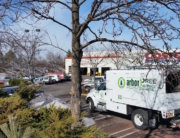We’ve had quite a strange winter, although it seems that the general trend in Central Oregon is that winters are getting stranger. Between the warm rain, freezing fog and intense cold snaps, it’s all over the board. One thing is for sure – winter isn’t going away any time soon.
This region isn’t totally known for its ice storms, unlike Portland or the Southern U.S. States, but we do get the heavy snow or ice storms each winter. I can remember a few times last winter, waking up to an ice rink from freezing rain and ice. You know, the mornings when you need to chisel open your car door because there is a perfect layer of ice on your car.
Ice and heavy snow can impact trees as well. When ice forms and covers a tree, or heavy snow accumulates, it puts quite a strain on the branches, weakening the tree and potentially causing long-term damage. Trees that tend to suffer the worst damage include multiple leader, upright evergreens such as arborvitae and juniper, and multiple leader or clump trees like birch.
Keeping trees and large shrubs safe from ice damage is mostly common sense, but also takes a little bit maintenance and care.
- Your first instinct when you see a beloved tree drooping with ice weight may be to shake the limbs to remove the ice. Try not to do this! Branches coated in ice can be quite brittle and shaking them can cause breakage or damage. And that “snapping back” of the branches when you shake them can actually cause damage to the trees circulatory system. (Ouch!)
- Proper pruning is the best defense against winter ice storm damage. Pruning should focus on pruning hazardous, dead or weak-jointed branches before they become a problem. We can help you get your trees pruned properly!
- After a severe ice storm, if you notice some limb breakage, properly prune the damaged areas as soon as it is safe to do so. Better yet, hire a Certified Arborist (preferably us!) to determine what and how to prune.
- Safety first! If you see branches that are dangerously close or touching overhead power lines, notify the utility company immediately.
- Keep in mind that, when it comes to ice, age does not necessarily make a tree stronger. Younger trees tend to fare better in ice storms.
Most of our native trees hold up pretty well in our wild winter weather, but there are always a few that have a tough time. As always, feel free to contact us if you have questions, concerns, or need a consultation for your trees. Our goal is to keep Central Oregon trees happy and healthy year-round!
Send us an email or give us a call at 541-480-4223.
–Mike D. and Crew






